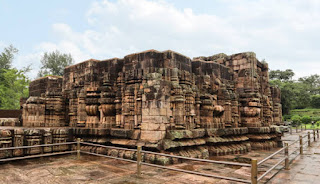THE WORLD FAMOUS HISTORICAL SUN TEMPLE (KONARK) IN ODISHA, INDIA
The Konark Temple ::- The Konark Sun temple Is A 13th Century CE (Year 1250) Sun temple At Konark About 35 Km (22ml) Northeast From Puri And 65 Km (40 ml) Southeast Of Bhubaneswar On The Bay Of Bengal Coastline In The State Of Odisha. The Temple Is Located In Eponymous Village ( Now NAC Area). The Temple Is Attributed To King Narasimha Deva Of The Eastern Ganga Dynasty About 1250 CE. This Temple Was Called the "Black Pagoda" In European Sailor Accounts As Early As 1676 Because It Looked Like A Great Tired Tower Which Appeared Black.
The Temple That Exists Today Was Partially Restored By The Conservation Efforts Of British Indian - Era Archaeological Teams. Declared A UNESCO World Heritage Site In 1984 It Remains A Major Pilgrimages Site For Hindus, Who Gather Here Every Year For The Chandrabhaga Mela Around The Month Of February. The Konark Sun Temple Was Built In 1250 CE During The Reign Of The Eastern Ganga King Narsimha Deva-1 From Stone In The Forms Of A Giant Ornamented Chariot Dedicated To The Sun God, Surya.
In Hindu Vedic Iconography Surya Is Represented As Rising In The East And Travelling Rapidly Across The Sky In A Chariot Drawn By Seven Horses. He Is Described Typically As A Resplendent Standing Parson Holding A Lotus Flower In Both His Hands. Rising The Chariot Marshaled By The Chariotee Aruna. The Seven Horses Are Named After The Seven Meters Of Sanskrit Prosody. Gayatri, Brihati, Ushnih, Jagati, Tristuba, Anustuba, And Pankti. Typically Seen Flanking Surya Are two Females Who Represent The Dawn Goddess.
The Goddess Are Shown To Be Shooting Arrows, A Symbol Of Their Initiative In Challenging The Darkness. The Architecture Is Also Symbolic, With The Chariots Twelve Pairs Of Wheels Corresponding To The Twelve Months Of The Hindu Calendar, Each Month Paired Into Two Cycles ( Shukla And Krishna). The Konark Temple Presents This Iconography On A Grand Scale. It Has 24 Elaborately Carved Stone Wheels Which Are Nearly 12 Feet (3.7 Mtr) In Diameter And Are Pulled By A Set Of Seven Horses When Viewed From Inland During The Dawn And Sunrise The Chariot. Shaped Temple Appears To Emerge From The Depths Of The Blue Sea Carrying The Sun.
The Konark Temple Is Also Known For Its Erotic Sculptures Of Maithuna's. There Show Couples In Various Stages Of Courtship And Intimacy And In Some Cases Coital Themes Notorious In The Colonials Era For Their Uninhibited Celebration Of Sexuality, There Images Are Included With Other Aspects Of Human Life As Well As Deities That Are Typically Associated With Tantra. This Led Some To Propose That The Erotic Sculptures Are Linked To The Vama Marga (Left Hand Tantra) Tradition. However This Is Not Supported By Local Literary Sources, And These Images May Be The Same Kama And Mithuna Scenes Found Integrated Into The Art Of Many Hindu Temples.
The Erotic Sculptures Are Found On The Temples Sikhara And These Illustrate All The Bandhas ( Mudra Forms) Described In The Kamasutra. The Temple Follows The Traditional Style Of Kalinga Architecture. It Is Oriented Towards The East So That The First Rays Of The Sunrise Strike The Main Entrance. The Temple Built From Khondalite Rocks, Was Originally Constructed At The Mouth Of The River Chandrabhaga, But The Water Line Has Receded Since Then, The Wheels Of The Temples Are Sundials, Which Can Be Used To Calculate Theme Accurately To A Minute.














0 Comments